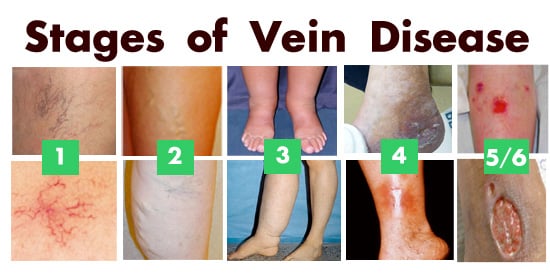
Vein disease can affect individuals very differently. One person may experience only the mildest forms; while others may experience more significant and painful symptoms. The only common ground these people have is that if they do not receive proper treatment for vein disease, it will worsen over time.
There are six separate classifications or stages of vein disease. Here is a brief look at each of them:
Stage one – Spider Veins. Spider veins are the mildest form of vein disease and are actually small blood vessels that appear at the surface of the skin. Called telangiectasia, they are dilated capillaries and veins.
Stage two — Varicose Veins or Ropey Veins. Varicose veins are more prominent than the smaller spider veins and can have a ropey or twisted appearance. It is at this stage when patients are aware they may be suffering from vein disease. Additionally, 75% of people with varicose veins say the symptoms interfere with their daily lives. These symptoms can include tingling, achiness, swelling, itchiness or a tired feeling in the legs. The best time to get vein treatment is at the first sign of any of these symptoms.
Stage three – Swelling or Edema without Skin Changes. As vein disease progresses, individuals may start seeing a swelling in the legs. This swelling is caused by the backflow of the venous system that interferes with the body’s natural ability to absorb fluid. Symptoms can be relieved by elevating the legs, but this will not cure the disease.
Stage four — Skin Discoloration. As the disease progresses, the congestion of the veins can cause changes in the skin’s color, along with thinning of the skin. During this stage, the skin can be more easily injured and will take longer to heal.
Stage five — Skin Changes With Healed Ulceration. If skin ulcerations occur during this stage, treatments are available to enable healing to provide relief from the symptoms.
Stage six — Skin Changes with Active Ulcerations. This stage happens because of the improper functioning of the venous valves. These ulcerations can become chronic if left untreated, and will be extremely painful.
Advanced Stages
The last two stages are considered the most advanced forms of vein disease. The ulcerations may have progressed to a point where they interfere with proper blood flow that is necessary for providing nutrition to the skin. If ulcerations of the skin go untreated for extended periods of time, it is likely they will continue to become worse.
